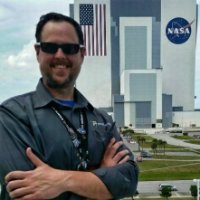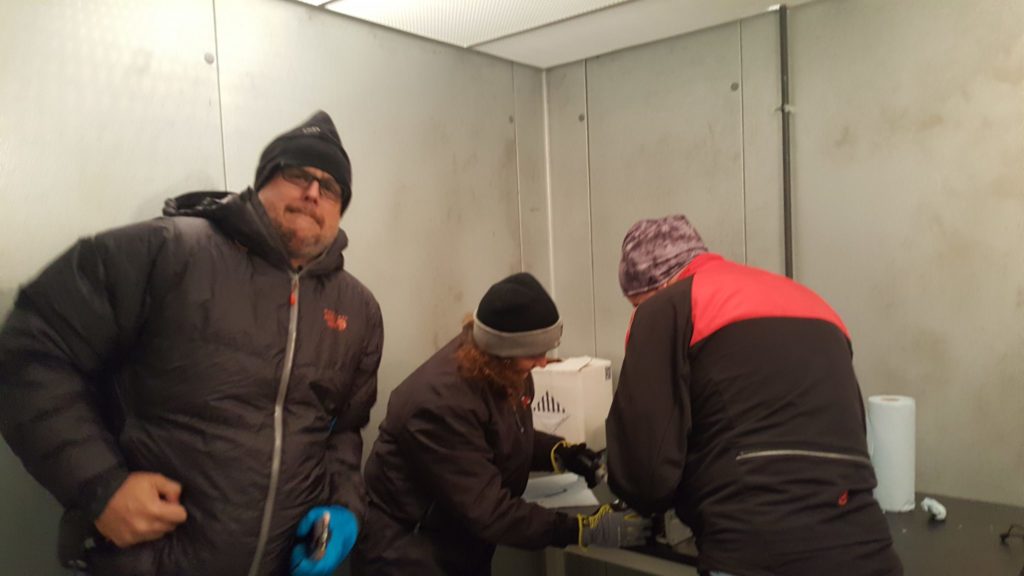
This is an interview with Carl Carruthers, Chief Scientist at NanoRacks, who played a leading role in testing and preparing both the Earth and ISS-bound Xtronaut Microbes in Space kits alongside Mariel Rico. In this interview, Carl shares what inspired him to reach for the stars, and what it took to make sure everything was perfect for Microbes in Space. Do you want to bring this science to your classroom or home? Contribute to the Kickstarter campaign to make it happen!
DreamUp: What’s your current role, and how did you get there?
Carl Carruthers: I’m NanoRacks Chief Scientist. I have a Ph.D. in Biochemistry and my science background entails the study of protein structures as well as how proteins recruit other proteins when turning on or off genes during an inflammation response. I have also flown seven of my own microgravity research experiments on the Space Shuttle, ISS and reduced gravity aircraft.
I started working for NanoRacks in January of 2014, but I met the founders of NanoRacks, Jeffery Manber and Michael Johnson while flying my own microgravity research projects on the space shuttle in 2011. We had some common ideas and beliefs in developing affordable microgravity hardware and experiments for researchers, so I left my lab bench behind to work for them to help develop those ideas further.
DU: What first sparked your interest in space?
CC: It likely wasn’t any one spark, but a whole sparkler of sparks. The mixture of exploration, science and engineering has always been the core part of my personality and certainly drove me towards my curiosity in space. Growing up in South Florida and my father being a bit of a technology and space nerd helped foster my space interests as well, since we would go see launches from the Kennedy Space Center as often as we could. I actually preferred it more than going to Disney World.
I was a curious, but shy kid, so while I didn’t ask “why” as often as I should have, if my parents didn’t know, I would teach myself the how or research the “why” from books and the internet. I never believed working in the space business was an option for me because I thought that was only for super geniuses and MIT graduates. As I started trying to find a single major in college, I was lucky enough to find a few professors and people that were crucial in helping me get my compass in one direction. It was through their mentorship with several hands on space related science projects that eventually built up my confidence enough to make me see I could work in the science and space sector.
DU: What does testing an experiment for flight entail? How is it different than testing for the ground?
CC: Testing an experiment for spaceflight entails good planning and attention to detail. Both of those skills help you plan on what you need before and during the experiment, as well as what you may not know you need (the hardest part!). In testing on the ground, it is relatively easy to do the experiment again if something doesn’t work or you forgot a step. With spaceflight experiments, you will only get one or two shots to get it right, since the astronauts have limited time and the cost and opportunity of sending and experiment to the ISS is still somewhat high and infrequent.
DU: What was your favorite part about participating in the Microbes in Space kit testing?
CC: The world is a very “dirty” place! We live in an ocean of microbes that are mostly invisible to us, but almost all of these living things are essential to life. Also, in their own weird way, the microbial growth patterns on the plates can be kinda pretty, as they have different shapes, colors and textures. Almost like an abstract painting.
DU: Was there anything unexpected that you encountered in your testing?
CC:The initial design of the experiment was to show that places and items you may think are dirty are not as dirty as you may think, while items that you may think are OK are realllly dirty. This is because we tend to clean “dirty” places more than others so they don’t build up huge populations of microbes like a less frequently cleaned door handle or the bottom of your shoe does. This practice is OK when you’re dealing with the almost infinite space of the Earth (compared to a microbe’s size) but a whole different story when applied to a confined space like the International Space Station. Imagine never cleaning your home since it was built in 2000. Yuck!
DU: What do you think kids will find exciting about the Microbes in Space kit?
CC: I believe that kids will find the Microbes in Space Kit to be exciting because it allows them to perform a very standard laboratory technique that is fun to do. Also, you swab places that look like nothing is there and after a few days of growing on the plate…a whole community of things appear. I’ve done it hundreds of times and I still think it’s amazing!
Secondly, I anticipate this experiment will introduce kids to a new world of living things that we are completely immersed in, but rarely see. Everywhere humans eventually go in the universe we will take these microbes with us, so I hope they learn they are mostly our friends with helpful impacts on our lives.
DU: Why do you think it is important to get kids engaged in space research from an early age?
CC: My own philosophy is that it is essential kids get hands on experience in performing science projects. It takes science experiments, microbes or the ISS from a somewhat abstract thing in a book or on a TV show and connects it to something real. It is also immensely helpful for the kids in either realizing if they like doing something they otherwise didn’t know they liked, builds confidence that they do like it and can accomplish it or makes them realize they really don’t like it at all. Those are quality, connective experiences that simply can’t happen by watching or reading.

